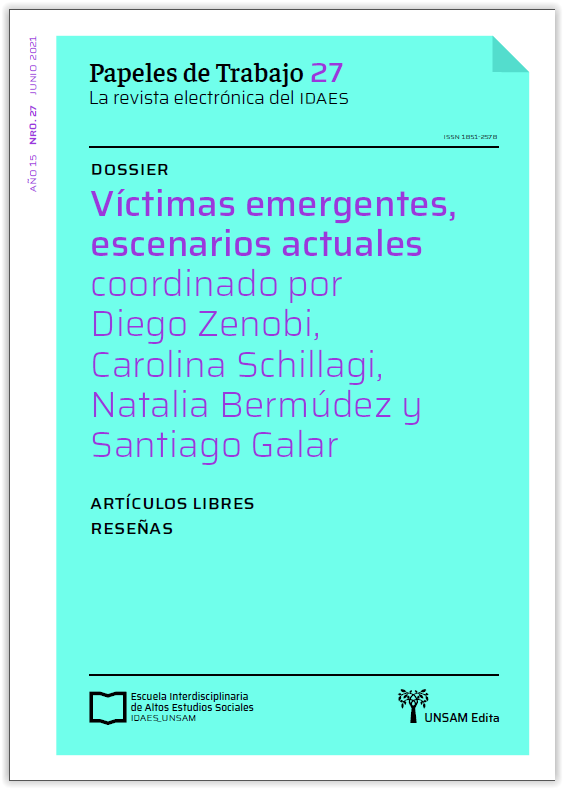La masacre de Villas de Salvárcar (Ciudad Juárez)
Un acontecimiento, tres figuras de víctimas
Keywords:
event, victims, political subjects, Ciudad JuárezAbstract
The aim of this article is to explore the relationship between two social processes: the process of configuration of an event and the emergence of victimhood. The event analyzed in this article is the Villas de Salvárcar massacre, which took place in Ciudad Juárez, México in the beginning of the fourth year of the so-called war on drugs in the country. The article analyzes how this massacre transforms into an event through different interventions of political subjects. Jointly, the process of configuration of three forms of victimhood takes place. The three forms are: 1) the victim as responsible for their own death; 2) the emergence of victims as political subjects after a dispute for their identity, and 3) the victim who is named and discussed by experts. These processes are analyzed in statements and newspaper articles that are the forms in which the event is materialized and through which it flows over time. The two processes are entangled, the movement of one piece in one process, moves the other.
References
Abbot, Andrew (1992). “From Causes to Events: Notes on Narrative Positivism”, Sociological Methods & Research, Vol. 20, No. 4, pp.428–55.
Badiou, Alain (2013). Being and Event. London ; New York, Bloomsbury Academic.
Bermúdez, Natalia Verónica (2016). “‘Algo habrán hecho...’. Un análisis sobre las contiendas morales en el acceso a la condición de activista familiar en casos de muertes violentas (Córdoba, Argentina)”, Antípoda. Revista de Antropología y Arqueología, No.25, pp.59–73.
Butler, Judith (2006). Precarious Life: The Power of Mourning And Violence. New York, Verso Books.
Butler, Judith (2016). Frames of War: When Is Life Grievable? New York, Verso Books.
Das, Veena (1996). Critical Events: An Antropological Perspective on Contemporary India. Oxford University Press.
de Lachica Huerta, Fabiola. 2020. “Shattering the Everyday, Rearranging the Ordinary. The Categories, Temporalities, and Spatial Dimensions of an Acute Event: The Case of the Villas de Salvarcar Massacre.” The New School, NY, USA.
de Lachica Huerta, Fabiola. 2021.“No diga por supuesto, señor presidente. Haga algo por Juárez.” La emergencia de sujetos políticos a partir de un acontecimiento.” En El acontecimiento al centro. Cuatro estudios desde la sociología y la historia, coordinado por Fabiola de Lachica Huerta y Alicia Márquez Murrieta. Instituto Mora.
Dosse, Francois (2013). “El Acontecimiento Histórico Entre Esfinge y Fénix”, Historia y Grafía, Vol. 2, No. 41.
Fassin, Didier, y Richard Rechtman (2009). The Empire of Trauma. An Inquiry into the Condition of Victimhood. University of California Press.
Felstiner, William L. F., Richard L. Abel, y Austin Sarat (1980). “The Emergence and Transformation of Disputes: Naming, Blaming, Claiming . . .”, Law & Society Review Vol. 15, No. ¾, pp.631–54.
Galar, Santiago (2017). “Casos conmocionantes, noticias policiales y prácticas periodísticas locales en ciudades pequeñas de la Provincia de Buenos Aires: el caso Antonia en Ayacucho, 2011”, Astrolabio, No.18, pp.173–96.
Gatti, Gabriel (2017). Un Mundo de Víctimas. Barcelona, Anthropos.
Gibler, John (2011). To Die in Mexico: Dispatches from Inside the Drug War. City Lights Books.
Griffin, Larry J. (1992). “Temporality, Events and Explanation in Historical Sociology: An Introduction”, Sociological Methods & Research, Vol. 20, No. 4, pp.403–27.
Humphrey, Caroline (2008). “Reassembling Individual Subjects. Events and Decisions in Troubled Times”, Anthropological Theory, Vol. 8, No. 4, pp.357–80.
Kenny, P., & Serrano, M. (2012). The Mexican State and Organized Crime. In Mexico’s Security Failure. Collapse into Criminal Violence. Nueva York: Routledge.
Mead, George Herbert. 2002. The Philosophy of the Present. Amherst, N.Y: Prometheus.
Pita, María Victoria (2010). Formas de morir y formas de vivir: el activismo contra la violencia policial. Ciudad Autónoma de Buenos Aires, Editores del Puerto, CELS, Centro de Estudios Legales y Sociales.
Pita, María Victoria (2020). “De Los Hechos a La Causa. Historia de Un Caso de Violencia Policial En La Ciudad de Buenos Aires” en Movilización de víctimas y demandas de justicia en la Argentina contemporánea, Colección Antropología Jurídica y Derechos Humanos. Buenos Aires, Teseo Press.
Pita, María Victoria, y Sebastián Pereyra (2020). “La Centralidad de Las Víctímas En La Movilización Social Contemporánea” en Movilización de víctimas y demandas de justicia en la Argentina contemporánea, Colección Antropología Jurídica y Derechos Humanos. Buenos Aires, Teseo Press.
Sahlins, Marshall (1991). “The Return of the Event, Again” en Clio in Oceanía, Toward a Historical Anthropology. Washington D.C, Smithsonian Institution Press.
Santamaría, Gema (2016). “From War-Making to Peacebuilding? Opportunities and Pirfalls of an Integral Approach to Armed Social Violence in México” en Undeclared Wars. Exploring a Peacebuilding Approach to Armed Social Violence, Berghof Handbook Dialoge Series. Berlin, Berghof Foundation.
Schedler, Andreas (2016). “The Criminal Community of Victims and Perpetrators: Cognitive Foundations of Citizen Detachment From Organized Violence in Mexico”, Human Rights Quarterly, Vol. 38, No. 4, pp.1038–69.
Schillagi, Carolina (2018). “El protagonismo público de las víctimas contemporáneas. Catástrofes, dispositivos y Estado en la Argentina”, Persona y Sociedad, Vol. 32, No. 2: pp. 25–45.
Sewell, William H (1996). “Historical Events as Transformations of Structures: Inventing Revolution at the Bastille”, Theory and Society, Vol. 25, No. 6, pp.841–81.
Torpey, John. (2001). “‘Making Whole What Has Been Smashed’: Reflections on Reparations”, The Journal of Modern History, Vol. 73, No. 2, pp.333–58.
Valenzuela Arce, J. M. (2009). El futuro ya fue. Socioantropología de los jóvenes en la modernidad. Tijuana, Baja California/ México D.F.: colef/ Juan Pablos.
Veyne, Paul (1994). Writting History. Middletown, Wesleyan Universtity Press.
Visacovsky, Sergio Eduardo (2011). Estados Críticos. La Experiencia Social de La Calamidad. La Plata, Al Margen.
Wagner-Pacifici, Robin (2017). What Is an Event? Chicago, University of Chicago Press.
Zenobi, Diego (2020). “Panorama Sobre La Producción Social de Las Víctimas Contemporáneas” en Movilización de víctimas y demandas de justicia en la Argentina contemporánea, Colección Antropología Jurídica y Derechos Humanos. Buenos Aires, Teseo Press.









